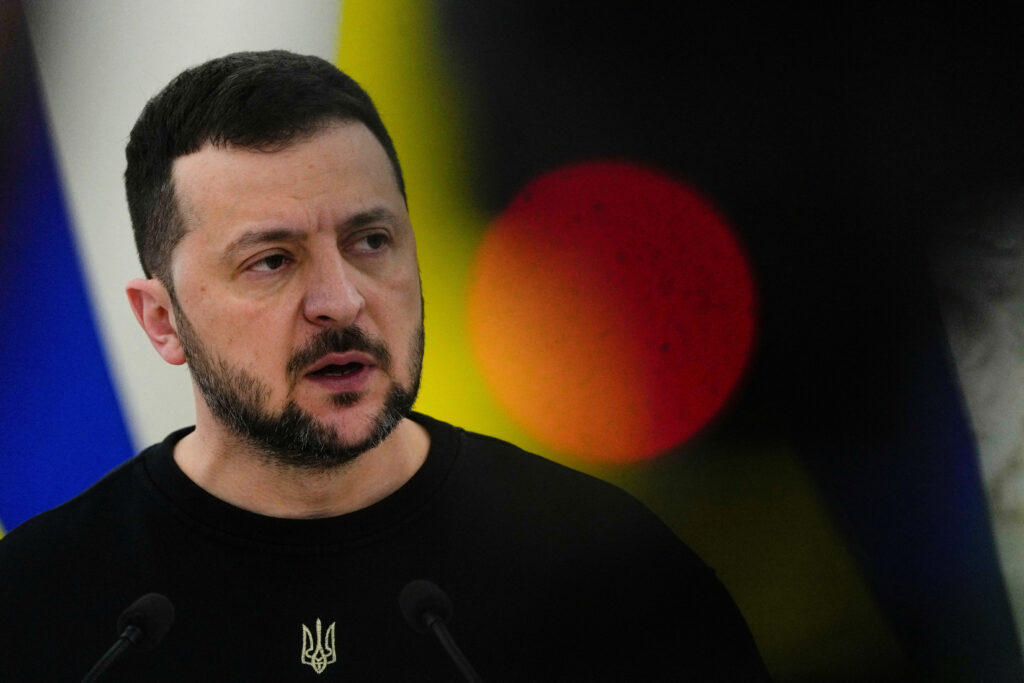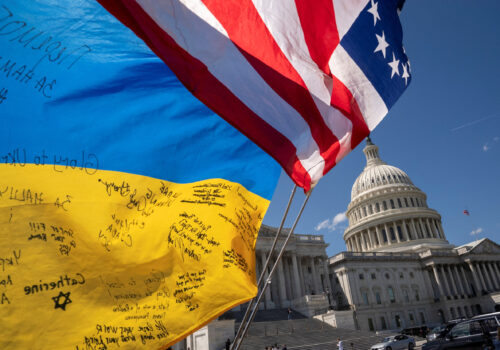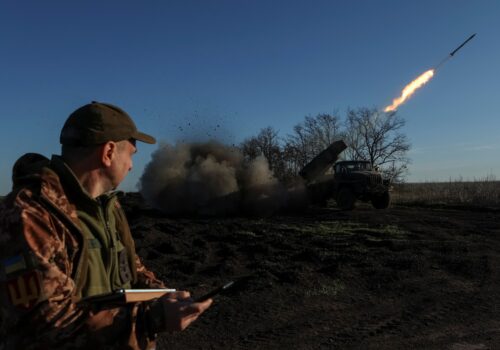The war in Ukraine could reach a decision point by the NATO summit. Policymakers need to prepare now.
Russia has launched its third major mobilization wave in anticipation of its upcoming spring/summer campaign to take more land in Ukraine. On March 31, Russian President Vladimir Putin signed a decree to begin the next conscription drive, setting the target at 150,000 new inductees slated for military service. This came after a decision in July of last year by the Russian Duma to raise the maximum age of conscription from twenty-seven to thirty, significantly increasing the pool of available recruits. Ukrainian estimates put the number of new soldiers that could be inducted in the third Russian mobilization drive at as many as three hundred thousand by June.
There are various assessments about the extent to which the Russian land forces have been reconstituted since Russia’s initial losses, with some analysts arguing that the process is nearly complete. But regardless of these various assessments, the gap between Russia’s and Ukraine’s military capabilities—and the difference in sheer mass—continues to grow apace, even though Kyiv recently lowered the draft age for Ukrainian males from twenty-seven to twenty-five. Recent frontline gains by Russia, along with US aid to Ukraine moving forward in Congress only after months of delays, suggest that a major decision point in the war may be approaching in the coming months. While the US House of Representatives at last agreed on Saturday to send $60.8 billion in aid to Ukraine, which means the United States could soon be sending desperately needed ammunition and air defenses to the front lines, a Russian push already appears to be in its early stages. And it could well create a crisis for the NATO alliance much bigger than the current grumbling over who is spending more on Ukraine’s behalf.
Considering that Russian infantry may receive as little as a few months’ training before they are thrown into battle—and the fact that Moscow continues to build new training facilities—it is likely that the new offensive will coincide or overlap with the upcoming seventy-fifth anniversary NATO summit in Washington on July 9-11. In line with official Russian propaganda that this war is being fought not just against Ukraine but against NATO, and that it is a civilizational struggle against the “collective West,” Putin could seize the opportunity to launch a major offensive during the Washington summit, with the intention of humiliating the Alliance precisely as it celebrates three-quarters of a century of containing Moscow’s imperial ambitions. In such a scenario, the US presidential election could become a defining variable in how the war ends. (Increasingly extreme scenarios of how the war may end following the US presidential election have already emerged in the European press.)
Simply put, if Putin launches a major push during the summit, would the Biden administration be able to maintain its “as long as it takes” strategy of sustaining Ukraine while minimizing the risk of nuclear escalation? Or would a Russian breakthrough in Ukraine be seen by the president’s reelection team as an untenable liability just months before the vote, especially given that his likely Republican opponent would be certain to make the failure of US policy in Ukraine an issue in the campaign?
A shared vision of victory in Ukraine
The monthslong delay of approving additional US aid to Ukraine, and the fact that Kyiv got serious about building up its defenses only six months ago, increase the country’s vulnerabilities and the prospect that the latest Russian offensive may achieve a breakthrough, or at the very least widen the front. However, the biggest problem remains the Biden administration’s overall approach of providing just enough aid to Kyiv so that Ukraine can hold the line, while draining Russian warfighting capabilities and limiting the risk of nuclear escalation. This position taken by the Biden administration has, for example, allowed Chancellor Olaf Scholz of Germany, the largest power in Europe, to sustain his “Russia must not win, Ukraine must not lose” strategic ambiguity, which stays the course toward eventual negotiations with Moscow to end the conflict.
Given the perceived stalemate on land, and despite clear Ukrainian gains at sea, some analysts today are indeed coming to the view that the war in Ukraine is heading for a negotiated settlement. In such a hypothetical settlement, Ukraine would preserve its sovereignty and independence while Russia keeps its territorial gains in the east, plus Crimea. Setting aside the fact that such an outcome would be tantamount to a Russian victory, these predictions could be undone by developments on the ground, much as the prevailing view in early 2022 that Ukraine would fall fast and resort to guerrilla operations was invalidated by Kyiv’s staunch resolve to stand its ground and fight. So, rather than incessantly speculating about this or that territorial settlement or this or that negotiated deal, what Ukraine and the transatlantic community need most urgently is a shared vision of victory in Ukraine, one that Kyiv and its supporters can rally around. Next, the United States and its allies and partners need a strategy—with resources to match—that will allow Ukraine to achieve that victory. After all, to rephrase a cliché, visions without resources are merely hallucinations.
In the coming months, the Biden administration could change course on Ukraine. If the Russians advance in Ukraine, the administration would have two choices: stay the course and increase the risk of Ukrainian losses, or shift from a “for as long as it takes” policy to an approach of “whatever the Ukrainians need to beat the Russians back.” This would potentially increase the risk of escalation with Russia, but it would also deflect the electoral risk of being blamed for the failure of US policy in Ukraine, while giving Kyiv a fighting chance to reach a favorable position from which to negotiate.
If Ukraine is to have a shot at reversing the tide on the battlefield, it will need to receive a large quantity of long-range artillery to strike at rail links, fuel depots, ammunition depots, command posts, and airfields deep inside Russian territory. Absent those weapons and authorities, another Ukrainian frontal assault on the Russian defensive line is likely to lead to widespread casualties for the Ukrainian army once again.
At the strategic level, the Biden administration and US allies across Europe need a serious public conversation about a vision of victory that goes beyond the assertions that Russia cannot win in Ukraine and that the West’s enduring commitment to Ukraine remains unshakeable. The transatlantic community needs a forthright discussion of the end state it wants, in clearly defined geostrategic terms rather than open-ended general support, followed by a commitment of resources to achieve those goals.
This summer will likely bring a decision point when it comes to US Ukraine policy. Depending on what happens in the next several months, the conflict may move into uncharted territory.
Andrew A. Michta is senior fellow and director of the Scowcroft Strategy Initiative at the Atlantic Council. Views expressed here are his own.
Further reading
Sun, Apr 21, 2024
‘A bad day for Putin’: US aid vote gives Ukrainians renewed hope
UkraineAlert By Peter Dickinson
Ukrainians let out a collective sigh of relief on Saturday as the US House of Representatives passed a long-delayed $61 billion aid bill that will provide Ukraine with a crucial lifeline in the struggle against Russian aggression, writes Peter Dickinson.
Sat, Apr 20, 2024
Renewed US assistance opens a path to success, if Ukraine’s friends move fast
New Atlanticist By Daniel Fried
The delay in US aid was deadly for Ukraine and damaging to US credibility. Now that aid is likely on its way, what’s needed next to help Ukraine fend off an expected Russian land offensive?
Sat, Apr 20, 2024
The House passed Ukraine aid at last. Here’s what it means.
Fast Thinking By
After months of costly delays, new shipments of US military aid look set to head to Ukraine soon. Our experts weigh in on next steps from Washington, Kyiv, and the EU.
Image: Ukraine’s President Volodymyr Zelenskiy speaks during a press conference in Vilnius, Lithuania January 10, 2024. REUTERS/Ints Kalnins/File Photo




